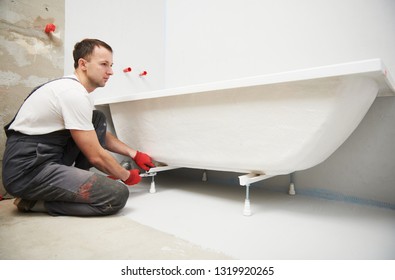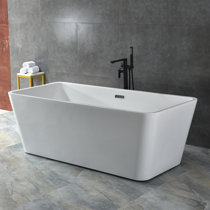DIY Tub Installation.
DIY Tub Installation.
Blog Article
We've come across the article about Installing A Bathtub directly below on the net and believe it made perfect sense to write about it with you on this site.

Mounting a bathtub isn't precisely brain surgery, yet it does call for strong plumbing, carpentry, and in some cases, tiling abilities. Changing an old tub with a brand-new one is additionally a reasonably hard task. If the old tub is readily available, the job can move rapidly; if you have to open a wall to eliminate the old tub and position the brand-new bath tub, the job is much harder. In either case, the job is within a house handyman's abilities, although you will certainly require an assistant to move out the old tub as well as set in the brand-new one. See to it you have actually certified yourself for the job and also fit attempting it. Rather than working with a contractor to take over a halfway-completed task, it is much better to consider using one before you begin. Possibilities are you might require a professional plumber to make tube connections.
This short article will certainly assist you set up a brand-new tub in your washroom if you have actually currently acquired a new tub and don't require to change the arrangement of your previous water pipelines.
Your devices as well as product checklist ought to make up the following:
Preparing for the Installation
First of all, the supporting structure provided with the bathroom needs to be fitted (if needed) according to the maker's directions. Next, fit the taps or mixer to the tub. When fitting the tap block, it is essential to ensure that if the tap comes with a plastic washer, it is fitted in between the bathroom as well as the taps. On a plastic bathroom, it is likewise practical to fit a supporting plate under the taps unit to prevent pressure on the tub.
Fit the versatile tap adapters to the bottom of both taps using 2 nuts and olives (sometimes provided with the bathtub). Fit the plug-hole electrical outlet by smearing mastic filler round the sink outlet hole, and afterwards pass the electrical outlet with the hole in the bath. Use the nut provided by the supplier to fit the plug-hole. Take a look at the plug-hole outlet for an inlet on the side for the overflow pipe.
Next off, fit completion of the versatile overflow pipe to the overflow outlet. After that, screw the pipeline to the overflow face which must be fitted inside the bath. See to it you utilize every one of the provided washers.
Connect the catch to the bottom of the waste electrical outlet on the bathtub by winding the string of the waste electrical outlet with silicone mastic or PTFE tape, as well as screw on the trap to the electrical outlet. Link the bottom of the overflow tube in a comparable manner.The bath should currently be ready to be fitted in its last setting.
Removing Old Touches
If you need to change old faucets with new ones as a part of your installment, then the first thing you must do is detach the supply of water. After doing so, turn on the faucets to drain any water continuing to be in the system. The process of removing the existing faucets can be rather troublesome due to the limited gain access to that is frequently the case.
Make use of a container wrench (crowsfoot spanner) or a tap device to reverse the nut that connects the supply pipelines to the taps. Have a cloth all set for the staying water that will come from the pipelines. When the supply pipes have actually been eliminated, use the very same tool to loosen the nut that holds the faucets onto the bath/basin. You will require to quit the single faucets from turning throughout this process. As soon as the taps have actually been gotten rid of, the holes in the bath/basin will have to be cleansed of any type of old securing compound.
Prior to moving on to fit the brand-new faucets, compare the pipeline connections on the old faucets to the brand-new taps. If the old faucets are longer than the new taps, after that a shank adapter is required for the brand-new faucets to fit.
Setting up the Bath tub
Using both wood boards under its feet, put the bath tub in the required setting. The wood boards are useful in uniformly spreading out the weight of the bathtub over the area of the boards as opposed to focusing all the weight onto four tiny points.
The following goal is to make certain that the bathtub is leveled all round. This can be accomplished by checking the spirit level and also changing the feet on the tub till the spirit level checks out degree.
To mount taps, fit the bottom of the outermost adaptable faucet connector to the suitable supply pipe by making a compression sign up with; after that do the same for the other tap.
Activate the water and check all joints as well as brand-new pipework for leakages and tighten them if necessary. Fill up the tub as well as additionally examine the overflow electrical outlet and the normal outlet for leaks.
Ultimately, deal with the bath paneling as described in the manufacturer's instruction manual. Tiling as well as securing around the tub must wait till the bathtub has been utilized a minimum of when as this will certainly resolve it right into its last placement.
Suitable New Touches
If the tails of the brand-new faucets are plastic, after that you will certainly require a plastic adapter to stop damages to the string. One end of the adapter fits on the plastic tail of the faucet and the other end gives a link to the current supply pipelines.
If you require to fit a monobloc, after that you will certainly require decreasing couplers, which links the 10mm pipeline of the monobloc to the typical 15mm supply pipeline.
Next off, place the tap in the mounting hole in the bath/basin guaranteeing that the washers are in place between the tap and the sink. Safeguard the tap in position with the maker supplied backnut. When the tap is securely in place, the supply pipelines can be attached to the tails of the taps. The taps can either be connected by utilizing corrugated copper piping or with regular tap ports. The former type needs to be attached to the faucet ends first, tightening up just by hand. The supply pipelines can later be attached to the other end. Tighten both ends with a spanner after both ends have been connected.
Tiling Around the Bath tub
In the location where the bath meets the floor tile, it is needed to seal the joins with a silicone rubber caulking. This is important as the installation can relocate enough to crack an inflexible seal, triggering the water to penetrate the wall surface in between the bath and the tiling, causing complications with wetness as well as feasible leakages to the ceiling below.
You can pick from a range of coloured sealants to assimilate your fixtures and installations. They are offered in tubes and cartridges, as well as are capable of securing spaces up to a width of 3mm (1/8 inch). If you have a larger space to fill, you can load it with twists of drenched newspaper or soft rope. Remember to always load the tub with water before securing, to permit the motion experienced when the bathtub is in usage. The sealant can fracture relatively early if you do not take into consideration this movement prior to sealing.
Conversely, ceramic coving or quadrant tiles can be utilized to border the bath or shower tray. Plastic strips of coving, which are easy to use and also cut to dimension, are also conveniently available on the marketplace. It is advisable to fit the ceramic tiles utilizing water-resistant or water-proof adhesive and grout.
Bathtub Installation
How Important Is A Bathtub To Your Home?
High-quality baths, showers, and other bathroom updates are necessary when considering a smart investment in your home. It’s a room that you go to every day and one that is constantly being used by guests.The bathroom is one of the top trafficked rooms in a home and also one of the most valuable in terms of home resale.
Install Piping Before Tub
You will be using your existing drain and waste vent system, but pipes required include the hot and cold water supply lines and a pipe leading to a shower head. A mixing valve and shower head are also needed. Air chambers may be required.
Position the Tub
Lower the tub into place so that the continuous flange fits against the wall studs and rests on 1’x4' or 2’x4' supports. Anchor the tub to the enclosure with nails or screws inserted through the flanges into the studs.
NOTE: Remember, bathtubs and shower stalls may require support framing. A bathtub filled with water is extremely heavy, so check building codes and framing support before installing the tub.
Assemble Drain Connections
Assemble the bathtub drain connections by connecting the tub overflow with the tub drain above the trap, not beyond it. The trap will have a compression fitting that screws over the arm of the overflow assembly.
Place a Pipe For the Shower Head
First, locate a brass female threaded winged fitting and attach it to a framing support via a screw or a nail. Then run a pipe up the wall for the shower head. Sweat or solder the other side of the brass fitting to the top of the pipe.
Attaching Hot and Cold Water Lines
Attach your water lines for both hot and cold by sweating these directly into the hot and cold ports of the mixing valve. The mixing valve will be how water enters the tub’s system, not by the pipes themselves.
Install the Spout
Extend a piece of 1/2 inch pipe, or whichever length is specified in the manufacturer’s instructions, for the tub spout. Sweat on a male threaded fitting at the end of the pipe or use a brass nipple of the proper length and a 1/2 inch cap.
NOTE: At this point you should have your rough-in plumbing work inspected before proceeding further.
Check For Leaks
Restore the water pressure and check the drain connection and the supply pipes for any sign of leaking.
estore the Bathroom Wall
Replace the wall with moisture-resistant drywall as a base for your wall covering. Seal the joints between the wall and your new tub with silicone caulk as protection against water seepage.
https://www.berkeys.com/2016/12/02/bathtub-installation-dallas/

I'm certainly very focused on Installing A Bathtub and I am hoping you enjoyed reading my blog post. Do you know somebody else who is very much interested in the subject? Do not hesitate to promote it. I love reading our article about Tools You Need to Install a New Bathtub .
Get Offer Report this page